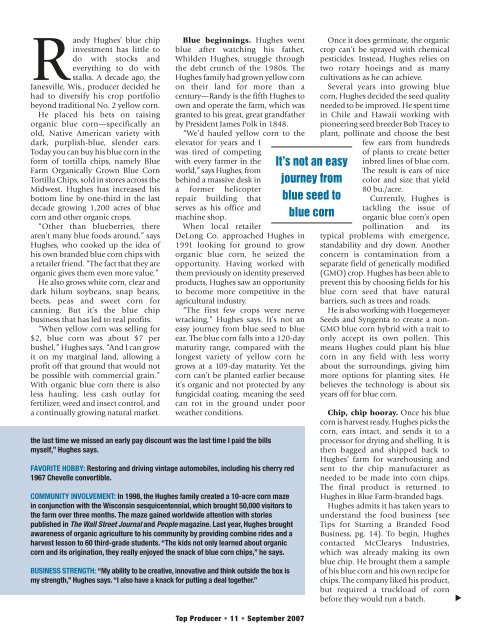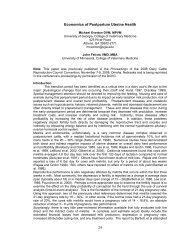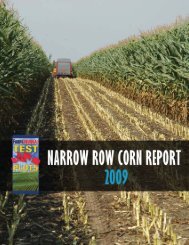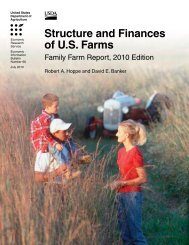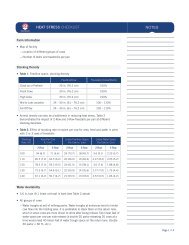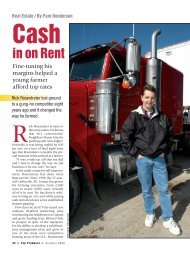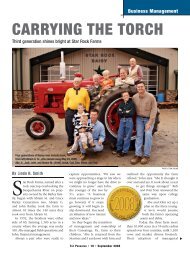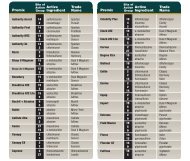You also want an ePaper? Increase the reach of your titles
YUMPU automatically turns print PDFs into web optimized ePapers that Google loves.
<strong>Randy</strong> <strong>Hughes</strong>’ blue chipinvestment has little todo with stocks andeverything to do withstalks. A decade ago, theJanesville, Wis., producer decided hehad to diversify his crop portfoliobeyond traditional No. 2 yellow corn.He placed his bets on raisingorganic blue corn—specifically anold, Native American variety withdark, purplish-blue, slender ears.Today you can buy his blue corn in theform of tortilla chips, namely BlueFarm Organically Grown Blue CornTortilla Chips, sold in stores across theMidwest. <strong>Hughes</strong> has increased hisbottom line by one-third in the lastdecade growing 1,200 acres of bluecorn and other organic crops.“Other than blueberries, therearen’t many blue foods around,” says<strong>Hughes</strong>, who cooked up the idea ofhis own branded blue corn chips witha retailer friend. “The fact that they areorganic gives them even more value.”He also grows white corn, clear anddark hilum soybeans, snap beans,beets, peas and sweet corn forcanning. But it’s the blue chipbusiness that has led to real profits.“When yellow corn was selling for$2, blue corn was about $7 perbushel,” <strong>Hughes</strong> says. “And I can growit on my marginal land, allowing aprofit off that ground that would notbe possible with commercial grain.”With organic blue corn there is alsoless hauling, less cash outlay forfertilizer, weed and insect control, anda continually growing natural market.Blue beginnings. <strong>Hughes</strong> wentblue after watching his father,Whilden <strong>Hughes</strong>, struggle throughthe debt crunch of the 1980s. The<strong>Hughes</strong> family had grown yellow cornon their land for more than acentury—<strong>Randy</strong> is the fifth <strong>Hughes</strong> toown and operate the farm, which wasgranted to his great, great grandfatherby President James Polk in 1848.“We’d hauled yellow corn to theelevator for years and Iwas tired of competingwith every farmer in theworld,” says <strong>Hughes</strong>, frombehind a massive desk ina former helicopterrepair building thatserves as his office andmachine shop.When local retailerDeLong Co. approached <strong>Hughes</strong> in1991 looking for ground to groworganic blue corn, he seized theopportunity. Having worked withthem previously on identity preservedproducts, <strong>Hughes</strong> saw an opportunityto become more competitive in theagricultural industry.“The first few crops were nervewracking,” <strong>Hughes</strong> says. It’s not aneasy journey from blue seed to blueear. The blue corn falls into a 120-daymaturity range, compared with thelongest variety of yellow corn hegrows at a 109-day maturity. Yet thecorn can’t be planted earlier becauseit’s organic and not protected by anyfungicidal coating, meaning the seedcan rot in the ground under poorweather conditions.the last time we missed an early pay discount was the last time I paid the billsmyself,” <strong>Hughes</strong> says.FAVORITE HOBBY: Restoring and driving vintage automobiles, including his cherry red1967 Chevelle convertible.COMMUNITY INVOLVEMENT: In 1998, the <strong>Hughes</strong> family created a 10-acre corn mazein conjunction with the Wisconsin sesquicentennial, which brought 50,000 visitors tothe farm over three months. The maze gained worldwide attention with storiespublished in The Wall Street Journal and People magazine. Last year, <strong>Hughes</strong> broughtawareness of organic agriculture to his community by providing combine rides and aharvest lesson to 60 third-grade students. “The kids not only learned about organiccorn and its origination, they really enjoyed the snack of blue corn chips,” he says.BUSINESS STRENGTH: “My ability to be creative, innovative and think outside the box ismy strength,” <strong>Hughes</strong> says. “I also have a knack for putting a deal together.”Top Producer • 11 • September 2007It’s not an easyjourney fromblue seed toblue cornOnce it does germinate, the organiccrop can’t be sprayed with chemicalpesticides. Instead, <strong>Hughes</strong> relies ontwo rotary hoeings and as manycultivations as he can achieve.Several years into growing bluecorn, <strong>Hughes</strong> decided the seed qualityneeded to be improved. He spent timein Chile and Hawaii working withpioneering seed breeder Bob Tracey toplant, pollinate and choose the bestfew ears from hundredsof plants to create betterinbred lines of blue corn.The result is ears of nicecolor and size that yield80 bu./acre.Currently, <strong>Hughes</strong> istackling the issue oforganic blue corn’s openpollination and itstypical problems with emergence,standability and dry down. Anotherconcern is contamination from aseparate field of genetically modified(GMO) crop. <strong>Hughes</strong> has been able toprevent this by choosing fields for hisblue corn seed that have naturalbarriers, such as trees and roads.He is also working with HoegemeyerSeeds and Syngenta to create a non-GMO blue corn hybrid with a trait toonly accept its own pollen. Thismeans <strong>Hughes</strong> could plant his bluecorn in any field with less worryabout the surroundings, giving himmore options for planting sites. Hebelieves the technology is about sixyears off for blue corn.Chip, chip hooray. Once his bluecorn is harvest ready, <strong>Hughes</strong> picks thecorn, ears intact, and sends it to aprocessor for drying and shelling. It isthen bagged and shipped back to<strong>Hughes</strong>’ farm for warehousing andsent to the chip manufacturer asneeded to be made into corn chips.The final product is returned to<strong>Hughes</strong> in Blue Farm-branded bags.<strong>Hughes</strong> admits it has taken years tounderstand the food business (seeTips for Starting a Branded FoodBusiness, pg. 14). To begin, <strong>Hughes</strong>contacted McClearys Industries,which was already making its ownblue chip. He brought them a sampleof his blue corn and his own recipe forchips. The company liked his product,but required a truckload of cornbefore they would run a batch.▼


